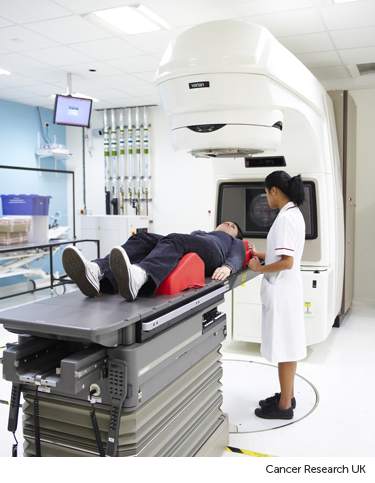Conformal radiotherapy
Conformal radiotherapy shapes the radiation beams to closely fit the area of the cancer. It is also called 3D conformal radiotherapy or 3DCRT. It is a very common type of radiotherapy.
Intensity modulated radiotherapy (IMRT) is a type of conformal radiotherapy.
Planning conformal radiotherapy
Planning conformal radiotherapy treatment involves several steps.
You usually have a CT scan to create a 3D image that your radiotherapy plan will be based on. You might also have an MRI or PET scan. The information from these scans feeds directly into the radiotherapy planning computer.
The treatment team then plan your radiotherapy treatment area in 3 dimensions:
- width
- height
- depth
The computer programme designs radiation beams that follow the shape of the tumour very closely. They make sure that all of the tumour is inside the radiotherapy field. And they avoid as much healthy tissue as possible. This reduces the risk of side effects.
Skin markings
The radiographers might make marks on your skin that act as reference points. This is to make sure every treatment session is accurate.

Radiotherapy masks and moulds
If you have radiotherapy to your head or neck, you may need to wear a radiotherapy mask during your treatment. This is also called a shell or mould.
Most types of masks are made of a mesh material with lots of small holes. You can have a mould for other parts of the body, such as the breast or limbs.
The mould or mask keeps the treatment area completely still. This is so your treatment will be as accurate as possible.

After the planning session
You usually have to wait a few days or up to 2 weeks for your treatment plan to be ready.
You then get an appointment for your first session of radiotherapy.
Having your treatment
To have the treatment you lie on a radiotherapy couch. The radiographers help you to get into the right position and put on any moulds that you may need.

Once you are in the right position your radiographers leave you alone in the room. This is so they are not exposed to radiation. You are alone for around 15 to 30 minutes. Your radiographers watch you carefully on a closed circuit television screen (CCTV) and can speak to you through an intercom.
They often take x-rays before you have the treatment. This is to ensure that you're in the correct position and is called image guided radiotherapy (IGRT). You might have x-rays before every treatment. Sometimes more than one x-ray might be taken if the radiographers have made a change to your position on the treatment couch.
You can't feel anything when you actually have the treatment. It doesn’t hurt but the couch is hard and you might feel uncomfortable.
The machine may beep from time to time.
Possible side effects
Conformal radiotherapy aims to reduce side effects. This is because less normal tissue is exposed to radiation. Unfortunately you're likely to still get some side effects.
As with any external beam radiotherapy, the side effects only affect the part of the body that the radiotherapy is aimed at.



